Comprehensive Ecological Planning and Evaluation of Towns from the Perspective of Sustainable Development
Abstract
:1. Introduction
2. Basic Information of Yuntai Town
2.1. Overview of Physical Geography of Yuntai Town
2.2. Social and Economic Overview of Yuntai Town
2.3. Biological Information of Yuntai Town
3. Development of Comprehensive Ecological Planning Indicator System
3.1. Comprehensive Ecological Township Development Evaluation Index System
3.2. Key Planning Points for Comprehensive Ecological Townships
4. Comprehensive Ecological Development Evaluation of Yuntai Town
4.1. Hierarchical Model Development for Evaluation Indicators and Weights Confirmation
4.2. Single Factor Evaluation Method and Comprehensive Evaluation Results
4.3. Analysis of the Advantages of Yuntai Town
4.4. Analysis of Restrictive Factors in Yuntai Town
5. Comprehensive Ecological Planning Analysis of Yuntai Town
5.1. Planning of Ecological Environment Functional Zone in Yuntai Town
5.2. Planning of Ecological and Economic Functional Zones in Yuntai Town
5.3. Benefit Analysis of Comprehensive Ecological Planning in Yuntai Town
6. Discussion
Author Contributions
Funding
Institutional Review Board Statement
Informed Consent Statement
Data Availability Statement
Conflicts of Interest
References
- Banerjee, S.; Khan, M.A.; Husnain, M. Searching appropriate system boundary for accounting india’s emission inventory for the responsibility to reduce carbon emissions. J. Environ. Manag. 2021, 295, 112907. [Google Scholar] [CrossRef]
- Moretti, S.; BErtoncini, E.I.; Abreujunior, C.H. Characterization of raw swine waste and effluents treated anaerobically: Parameters for Brazilian environmental regulation construction aiming agricultural use. J. Mater. Cycles Waste Manag. 2021, 23, 165–176. [Google Scholar] [CrossRef]
- Graafland, J.; BovenbErg, L. Government regulation, business leaders’ motivations and environmental performance of SMEs. J. Environ. Plan. Manag. 2020, 63, 1335–1355. [Google Scholar] [CrossRef]
- Bao, Q.; Shao, M.; Yang, D. Environmental regulation, local legislation and pollution control in China. Environ. Dev. Econ. 2021, 26, 321–339. [Google Scholar] [CrossRef]
- Hoang, T.; Nguyen, T.; Phan, T. Government environmental regulation, corporate social responsibility, ecosystem innovation strategy and sustainable development of Vietnamese seafood enterprises. Int. J. Data Netw. Sci. 2021, 5, 713–726. [Google Scholar] [CrossRef]
- Xu, X.; Cui, Y.; Zhong, Y. Impact of Environmental Regulation and FDI on Green Total Factor Productivity: Evidence from China. Environ. Eng. Manag. J. 2021, 20, 177–184. [Google Scholar] [CrossRef]
- Sun, H.; Gao, G. Research on the carbon emission regulation and optimal state of market structure: Based on the perspective of evolutionary game of different stages. RAIRO-Oper. Res. 2022, 56, 2351–2366. [Google Scholar] [CrossRef]
- Li, Z.; Zhang, J.; Sun, Q.; Shi, W.; Tao, T.; Fu, Y. Moxifloxacin detection based on fluorescence resonance energy transfer from carbon quantum dots to moxifloxacin using a ratiometric fluorescence probe. New J. Chem. 2022, 46, 4226–4232. [Google Scholar] [CrossRef]
- Li, Y.; Chiu, Y.H.; Liu, Y.; Lin, T.Y.; Chang, T.H. The Impact of the Media and Environmental Pollution on the Economy and Health Using a Modified Meta 2-Stage EBM Malmquist Model. INQUIRY J. Health Care Organ. Provis. Financ. 2020, 57, 105–116. [Google Scholar] [CrossRef]
- Yan, C.; Di, D.; Li, G.; Wang, J. Environmental regulation and the supply efficiency of environmental public services: Evidence from environmental decentralization of 289 cities in China. Growth Chang. 2022, 53, 515–535. [Google Scholar] [CrossRef]
- Ibrahim, R.L.; Al-mulali, U.; Ozturk, I.; Bello, A.K.; Raimi, L. On the criticality of renewable energy to sustainable development: Do green financial development, technological innovation, and economic complexity matter for China? Renew. Energy 2022, 199, 262–277. [Google Scholar] [CrossRef]
- Wang, X.; Wang, Q. Research on the impact of green finance on the upgrading of China’s regional industrial structure from the perspective of sustainable development. Resour. Policy 2021, 74, 102436. [Google Scholar] [CrossRef]
- Hsu, C.C.; Quang-Thanh, N.; Chien, F.S.; Li, L.; Mohsin, M. Evaluating green innovation and performance of financial development: Mediating concerns of environmental regulation. Environ. Sci. Pollut. Res. 2021, 28, 57386–57397. [Google Scholar] [CrossRef]
- Ebenuwa, A.U.; Tee, K.F.; Zhang, Y. Fuzzy-Based Multi-Objective Design Optimization of Buried Pipelines. Int. J. Uncertain. Fuzziness Knowl.-Based Syst. 2021, 29, 209–229. [Google Scholar] [CrossRef]
- Atanassov, K.T. New topological operator over intuitionistic fuzzy sets. J. Comput. Cogn. Eng. 2022, 1, 94–102. [Google Scholar] [CrossRef]
- Vasko, F.J.; Lu, Y.; McNally, B. A Simple Methodology that Efficiently Generates All Optimal Spanning Trees for the Cable-Trench Problem. J. Comput. Cogn. Eng. 2022, 1, 13–20. [Google Scholar] [CrossRef]
- Wang, Z.J. Eigenproblem driven triangular fuzzy analytic hierarchy process. Inf. Sci. 2021, 578, 795–816. [Google Scholar] [CrossRef]
- Duan, Y.; Xiong, J.; Cheng, W.; Wang, N.; Li, Y.; He, Y.; Liu, J.; He, W.; Yang, G. Flood vulnerability assessment using the triangular fuzzy number-based analytic hierarchy process and support vector machine model for the Belt and Road region. Nat. Hazards J. Int. Soc. Prev. Mitig. Nat. Hazards 2022, 110, 269–294. [Google Scholar] [CrossRef]
- Weng, G.; Pan, Y.; Li, J. Study on the Influencing Factors and Acting Path of the Sustainable Development of Rural Tourism Based on EEAM-ISM Model. Sustainability 2021, 13, 5682. [Google Scholar] [CrossRef]
- Liu, X.; Liu, H.; Wan, Z.; Wang, L.; Chen, Q. Study on evaluation index system of sustainable development of mine water resources based on PSO-AHP model and fuzzy comprehensive evaluation. J. Intell. Fuzzy Syst. Appl. Eng. Technol. 2021, 41, 4253–4264. [Google Scholar] [CrossRef]
- Meethom, W.; Koohathongsumrit, N. A decision support system for road freight transportation route selection with new fuzzy numbers. Foresight 2020, 22, 505–527. [Google Scholar] [CrossRef]
- Tafesse, S.; Girma, Y.E.; Dessalegn, E. Analysis of the socio-economic and environmental impacts of construction waste and management practices. Heliyon 2022, 8, e09169. [Google Scholar] [CrossRef] [PubMed]
- Cheemakurthy, H.; Garme, K. Fuzzy AHP-Based Design Performance Index for Evaluation of Ferries. Sustainability 2022, 14, 3680. [Google Scholar] [CrossRef]
- Pan, W.; Xu, X.; Ming, H.; Chang, C.K. Clustering Mashups by Integrating Structural and Semantic Similarities Using Fuzzy AHP. Int. J. Web Serv. Res. (IJWSR) 2021, 18, 34–57. [Google Scholar] [CrossRef]
- Noorollahi, Y.; Senani, A.G.; Fadaei, A.; Simaee, M.; Moltames, R. A framework for GIS-based site selection and technical potential evaluation of PV solar farm using Fuzzy-Boolean logic and AHP multi-criteria decision-making approach. Renew. Energy 2022, 186, 89–104. [Google Scholar] [CrossRef]
- Wang, H. Construction of a Near-Natural Estuarine Wetland Evaluation Index System Based on Analytical Hierarchy Process and Its Application. Water 2021, 13, 2116. [Google Scholar] [CrossRef]
- Othman, A.G.; Ali, K.H.; Wan, M. Application of Geographic Information System (GIS) and Analytic Hierarchy Process (AHP) Technology to Study Land Use Change in Pendang, Kedah. Plan. Malays. 2021, 19, 226–237. [Google Scholar]
- Hou, J.; Qiao, J.; Han, X. Energy-Saving Clustering Routing Protocol for Wireless Sensor Networks Using Fuzzy Inference. IEEE Sens. J. 2022, 22, 2845–2857. [Google Scholar] [CrossRef]
- John, C.A.; Tan, L.S.; Tan, J.; Kiew, P.L.; Shariff, A.M.; Abdul Halim, H.N. Selection of Renewable Energy in Rural Area Via Life Cycle Assessment-Analytical Hierarchy Process (LCA-AHP): A Case Study of Tatau, Sarawak. Sustainability 2021, 13, 11880. [Google Scholar] [CrossRef]
- Githinji, T.W.; Dindi, E.W.; Kuria, Z.N.; Olago, D.O. Application of analytical hierarchy process and integrated fuzzy-analytical hierarchy process for mapping potential groundwater recharge zone using GIS in the arid areas of Ewaso Ng’iro—Lagh Dera Basin, Kenya. HydroResearch 2022, 5, 22–34. [Google Scholar] [CrossRef]
- Azam, M.H.; Hasan, M.H.; Abdulkadir, S.J.; Hassan, S. Prediction of Sunspots using Fuzzy Logic: A Triangular Membership Function-based Fuzzy C-Means Approach. Int. J. Adv. Comput. Sci. Appl. 2021, 12, 357–362. [Google Scholar] [CrossRef]
- Arora, J.; Tushir, M. An Enhanced Spatial Intuitionistic Fuzzy C-means Clustering for Image Segmentation. Procedia Comput. Sci. 2020, 167, 646–655. [Google Scholar] [CrossRef]
- Rahimi, S.A.; Kolahdoozi, M.; Mitra, A.; Salmeron, J.L.; Navali, A.M.; Sadeghpour, A.; Mir Mohammadi, S.A. Quantum-Inspired Interpretable AI-Empowered Decision Support System for Detection of Early-Stage Rheumatoid Arthritis in Primary Care Using Scarce Dataset. Mathematics 2022, 10, 496. [Google Scholar] [CrossRef]
- Banerjee, R.; De, S.; Dey, S. A Novel Facial Expression Recognition System using BMCSA Based Adaptive Neuro-Fuzzy Inference System. Int. J. Uncertain. Fuzziness Knowl.-Based Syst. IJUFKS 2021, 29, 791–813. [Google Scholar] [CrossRef]
- Meng, F. Safety Warning Model of Coal Face Based on FCM Fuzzy Clustering and GA-BP Neural Network. Multidiscip. Digit. Publ. Inst. 2021, 13, 1082. [Google Scholar] [CrossRef]
- Zhong, Y.; Hao, J.; Liao, R.; Wang, X.; Wang, F. Mechanical defect identification for gas-nsulated switchgear equipment based on time-frequency vibration signal analysis. High Volt. 2020, 6, 531–542. [Google Scholar] [CrossRef]
- Dong, Z.; Lin, L.; Cao, H.; He, X.; Chen, P.; Gao, C. Distribution Network Dynamic Reconfiguration Based on Improved Fuzzy C-Means Clustering with Time Series Analysis. IEEJ Trans. Electr. Electron. Eng. 2022, 17, 174–182. [Google Scholar] [CrossRef]
- Jakovljevic, M.; Timofeyev, Y.; Ranabhat, C.L.; Fernandes, P.O.; Teixeira, J.P.; Rancic, N.; Reshetnikov, V. Real GDP growth rates and healthcare spending–comparison between the G7 and the EM7 countries. Glob. Health 2020, 16, 64–76. [Google Scholar] [CrossRef]
- Yao, Z. Coordinated Development Practice of Urban Architectural Design and Urban and Rural Planning Based on Ecological Niche Theory. Eng. Adv. 2023, 3, 89–92. [Google Scholar] [CrossRef]
- Hu, C.; Wang, Z.; Wang, Y.; Sun, D.; Zhang, J. Combining MSPA-MCR model to evaluate the ecological network in Wuhan, China. Land 2022, 11, 213. [Google Scholar] [CrossRef]
- Jia, Z.; Jiao, Y.; Zhang, W.; Chen, Z. Rural tourism competitiveness and development mode, a case study from chinese township scale using integrated multi-source data. Sustainability 2022, 14, 4147. [Google Scholar] [CrossRef]
- Abdallah, S.B.; Parra-López, C.; Elfkih, S.; Suárez-Rey, E.M.; Romero-Gámez, M. Sustainability assessment of traditional, intensive and highly-intensive olive growing systems in Tunisia by integrating Life Cycle and Multicriteria Decision analyses. Sustain. Prod. Consum. 2022, 33, 73–87. [Google Scholar] [CrossRef]
- Fatemi, M.; Rezaei-Moghaddam, K.; Karami, E.; Hayati, D.; Wackernagel, M. An integrated approach of Ecological Footprint (EF) and Analytical Hierarchy Process (AHP) in human ecology: A base for planning toward sustainability. PLoS ONE 2021, 16, e0250167. [Google Scholar] [CrossRef]
- Liu, W.; Du, M.; Bai, Y. Mechanisms of Environmental Regulation’s Impact on Green Technological Progress—Evidence from China’s Manufacturing Sector. Sustainability 2021, 13, 1600. [Google Scholar] [CrossRef]
- Chen, X.; Chen, Z. Can China’s environmental regulations effectively reduce pollution emissions? Int. J. Environ. Res. Public Health 2021, 18, 4658. [Google Scholar] [CrossRef] [PubMed]
- Barma, M.; Modibbo, U.M. Multiobjective mathematical optimization model for municipal solid waste management with economic analysis of reuse/recycling recovered waste materials. J. Comput. Cogn. Eng. 2022, 1, 122–137. [Google Scholar] [CrossRef]
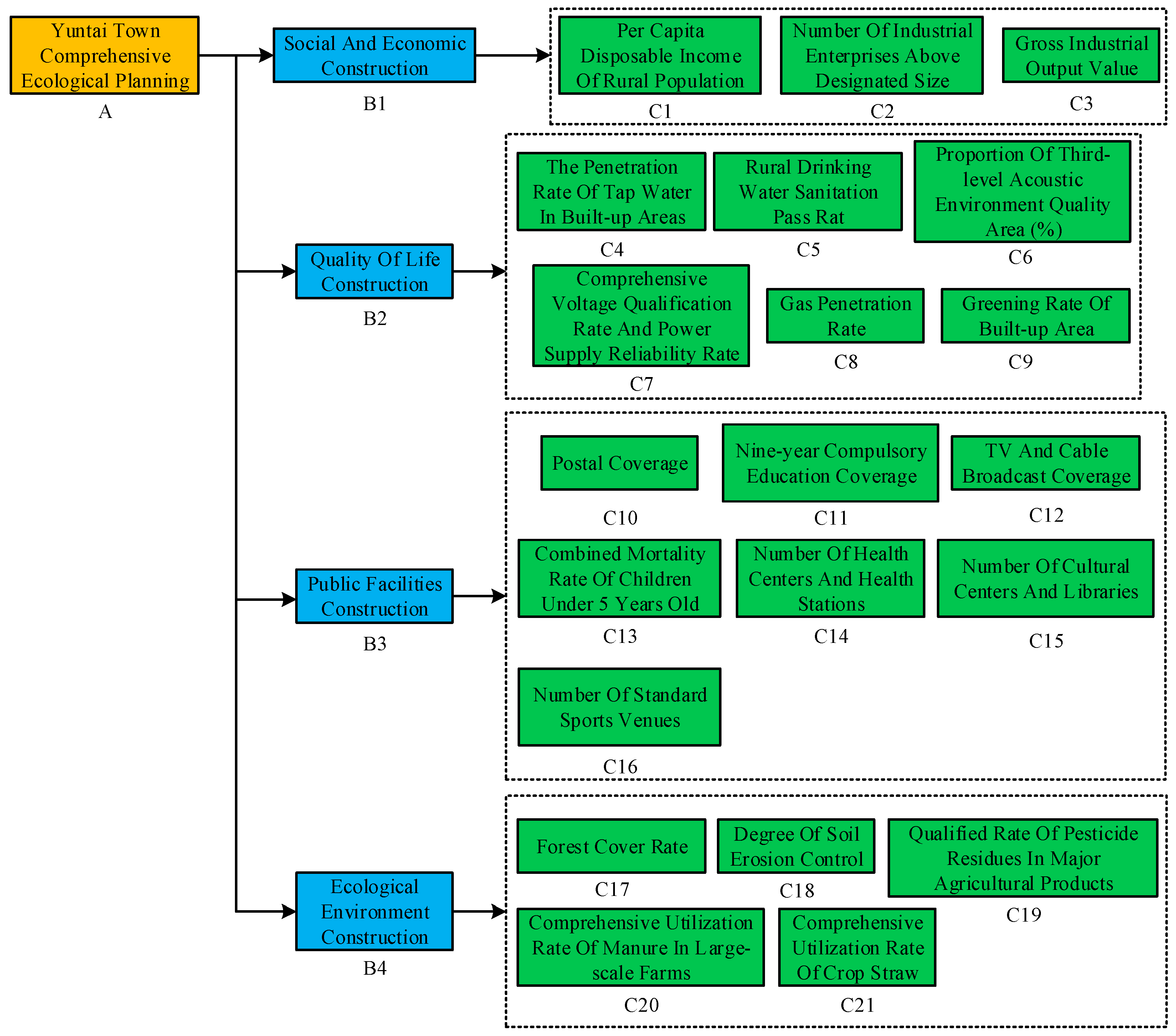

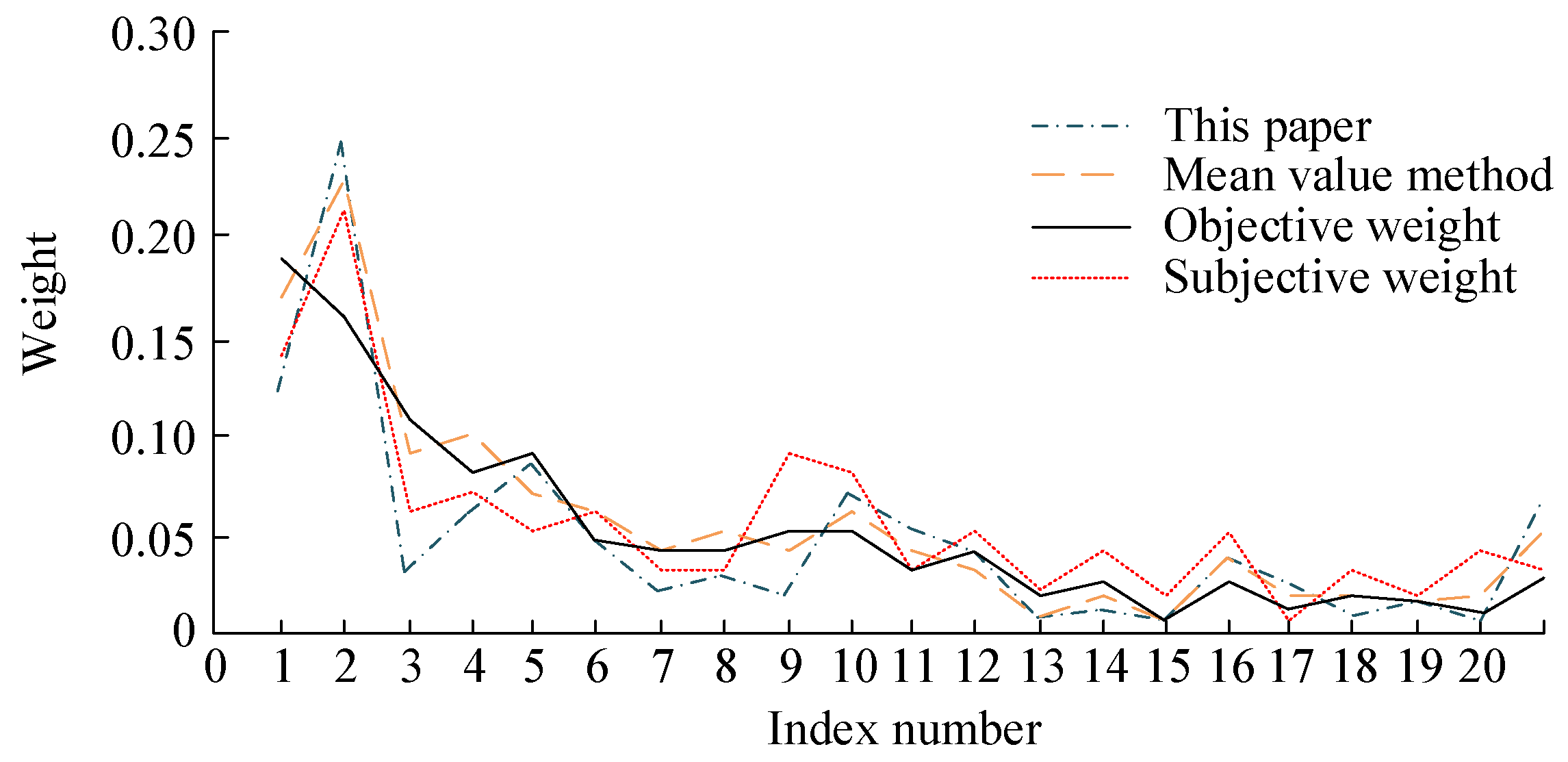
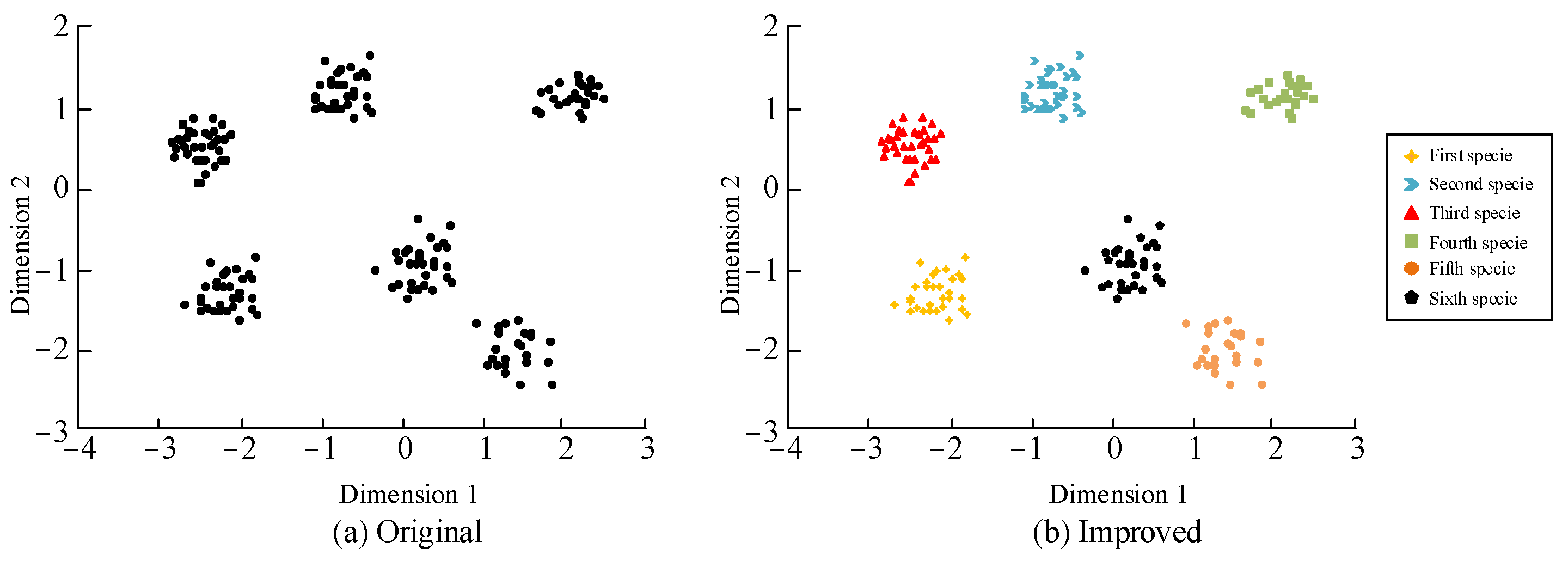
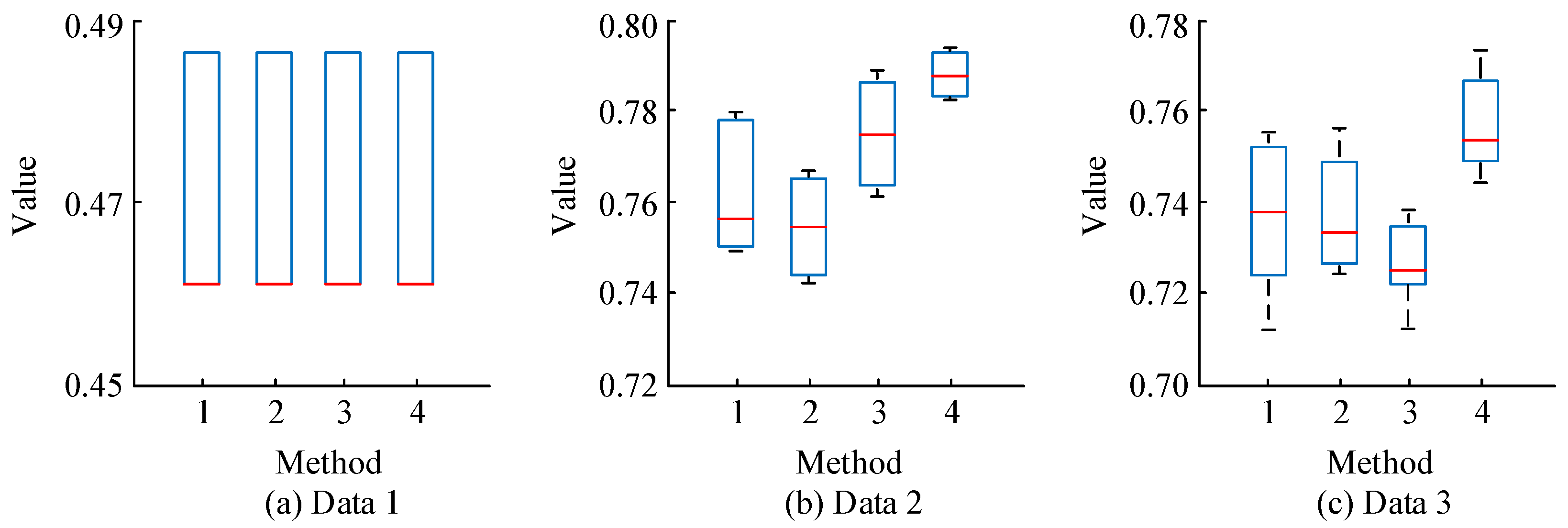

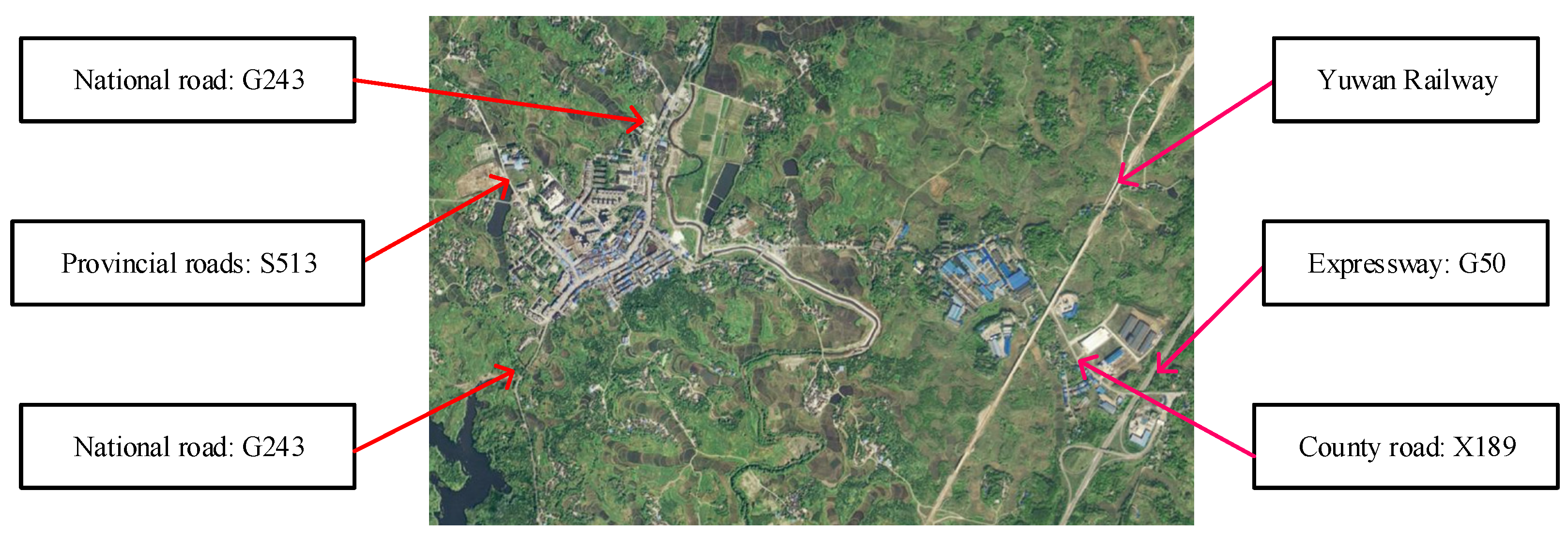


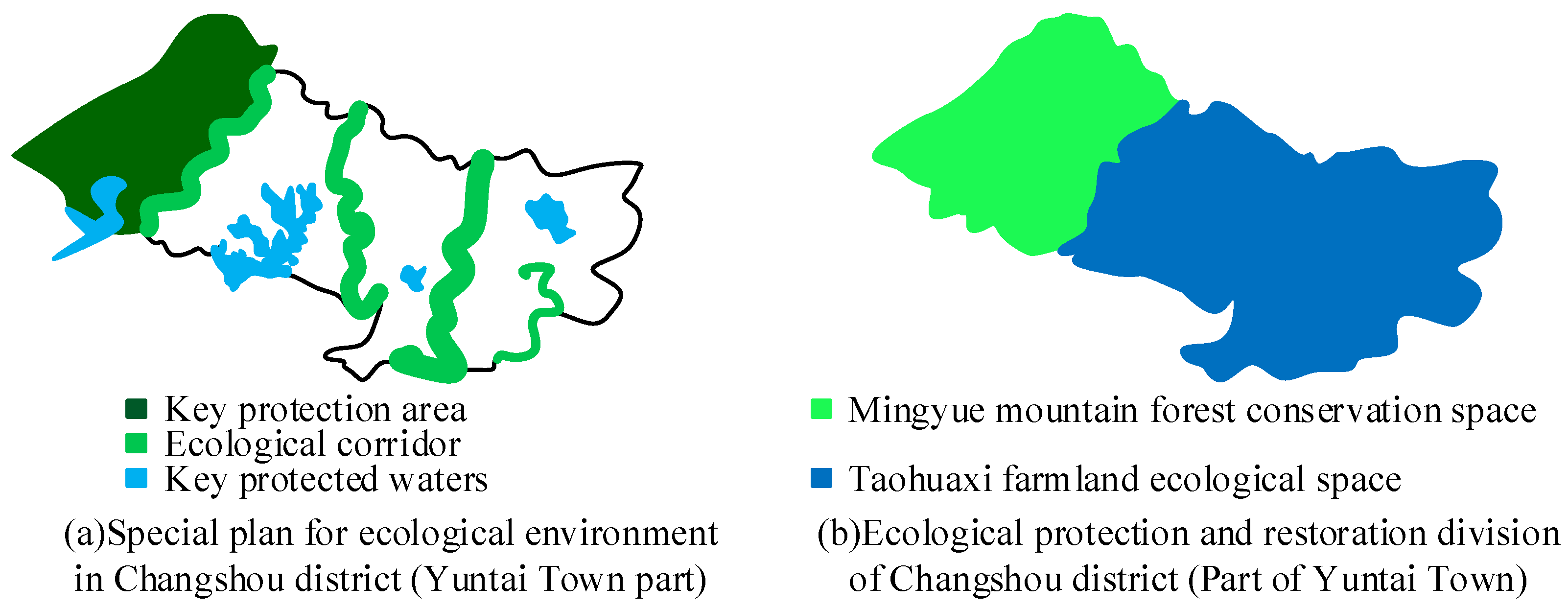


| Indicator Type | Index Serial Number | Index | 2020 Data | Compliance Status (Yes/No) |
|---|---|---|---|---|
| Social and economic development | 1 | Per capita disposable income of rural population (CNY/year) | 20,104 | Yes |
| 2 | Number of industrial enterprises above designated size | 7 | No | |
| 3 | Gross industrial output value (CNY billion/year) | 12.03 | No | |
| Quality of life development | 4 | The penetration rate of tap water in built-up areas (%) | 100 | Yes |
| 5 | Rural drinking water sanitation pass rate (%) | 99.7 | Yes | |
| 6 | Proportion of third-level acoustic environment quality area (%) | 3.07 | No | |
| 7 | Comprehensive voltage qualification rate and power supply reliability rate (%) | 100 | Yes | |
| 8 | Gas penetration rate (%) | 54.7 | No | |
| 9 | Greening rate of built-up area (%) | 43 | No | |
| Public facilities development | 10 | Postal coverage (%) | 100 | Yes |
| 11 | Nine-year compulsory education coverage (%) | 100 | Yes | |
| 12 | TV and cable broadcast coverage (%) | 100 | Yes | |
| 13 | Combined mortality rate of children under 5 years old (%) | 3.71 | Yes | |
| 14 | Number of health centers and health stations | 18 | Yes | |
| 15 | Number of cultural centers and libraries | 26 | Yes | |
| 16 | Number of standard sports venues | 11 | Yes | |
| Ecological environment development | 17 | Forest cover rate (%) | 72 | Yes |
| 18 | Degree of soil erosion control (%) | >7 | No | |
| 19 | Qualified rate of pesticide residues in major agricultural products (%) | >87 | No | |
| 20 | Comprehensive utilization rate of manure in large-scale farms (%) | >92 | Yes | |
| 21 | Comprehensive utilization rate of crop straw (%) | >97 | Yes |
| / | B1 | B2 | B3 | B4 | Weights |
|---|---|---|---|---|---|
| C1 | 0.3181 | / | / | / | 0.1217 |
| C2 | 0.2091 | / | / | / | 0.2481 |
| C3 | 0.4728 | / | / | / | 0.0301 |
| C4 | / | 0.2073 | / | / | 0.0598 |
| C5 | / | 0.4172 | / | / | 0.0849 |
| C6 | / | 0.0511 | / | / | 0.0462 |
| C7 | / | 0.1038 | / | / | 0.0203 |
| C8 | / | 0.1625 | / | / | 0.0281 |
| C9 | / | 0.0581 | / | / | 0.0183 |
| C10 | / | / | 0.3241 | / | 0.0699 |
| C11 | / | / | 0.2236 | / | 0.0520 |
| C12 | / | / | 0.0762 | / | 0.0403 |
| C13 | / | / | 0.1382 | / | 0.0069 |
| C14 | / | / | 0.0574 | / | 0.0108 |
| C15 | / | / | 0.0403 | / | 0.0057 |
| C16 | / | / | 0.1402 | / | 0.0371 |
| C17 | / | / | / | 0.1419 | 0.0238 |
| C18 | / | / | / | 0.0825 | 0.0078 |
| C19 | / | / | / | 0.2367 | 0.0151 |
| C20 | / | / | / | 0.3328 | 0.0053 |
| C21 | / | / | / | 0.2061 | 0.0678 |
| Indicator Type | Index Serial Number | Index | 2020 Data | Chinese Average | Chongqing Average | Changshou District Average | Single Factor Score |
|---|---|---|---|---|---|---|---|
| Social and economic development | 1 | Per capita disposable income of rural population (CNY/year) | 20,104 | 17,100 | 19,300 | 11,659 | 100 |
| 2 | Number of industrial enterprises above designated size | 7 | / | / | 16.17 | 43.75 | |
| 3 | Gross industrial output value (CNY billion/year) | 12.03 | / | / | 62.06 | 19.38 | |
| Quality of life development | 4 | The penetration rate of tap water in built-up areas (%) | 100% | 83% | 85% | 93.8% | 100 |
| 5 | Rural drinking water sanitation pass rate (%) | 99.7% | / | 52% | 86% | 100 | |
| 6 | Proportion of third-level acoustic environment quality area (%) | 3.07% | / | / | 5.30% | 57.92 | |
| 7 | Comprehensive voltage qualification rate and power supply reliability rate (%) | 100% | 97.9% | 99.769% | 99.99% | 100 | |
| 8 | Gas penetration rate (%) | 54.7% | / | 65.8% | 64.63% | 84.64 | |
| 9 | Greening rate of built-up area (%) | 38.7% | 42.6% | 42.9% | 34.9% | 100 | |
| Public facilities development | 10 | Postal coverage (%) | 100% | 81% | 86.91% | 92.8% | 100 |
| 11 | Nine-year compulsory education coverage (%) | 100% | 95.20% | 95.50% | 100% | 100 | |
| 12 | TV and cable broadcast coverage (%) | 100% | 99.38% | 99.40% | 100% | 100 | |
| 13 | Combined mortality rate of children under 5 years old (%) | 3.71% | 7.5% | 4.69% | 3.56% | 100 | |
| 14 | Number of health centers and health stations | 18 | / | 6.40 | 16.33 | 100 | |
| 15 | Number of cultural centers and libraries | 26 | 13.82 | 0.78 | 15.67 | 100 | |
| 16 | Number of standard sports venues | 11 | 8.97 | / | / | 100 | |
| Ecological environment development | 17 | Forest cover rate (%) | 72% | 23% | 43.1% | 47.5% | 100 |
| 18 | Degree of soil erosion control (%) | >70% | / | >90% | / | 63 | |
| 19 | Qualified rate of pesticide residues in major agricultural products (%) | >87% | 96.2% | 97.17% | / | 89.53 | |
| 20 | Comprehensive utilization rate of manure in large-scale farms (%) | >92% | >75% | >90% | >84% | 100 | |
| 21 | Comprehensive utilization rate of crop straw (%) | >97% | >85% | 88.96% | >87% | 100 |
Disclaimer/Publisher’s Note: The statements, opinions and data contained in all publications are solely those of the individual author(s) and contributor(s) and not of MDPI and/or the editor(s). MDPI and/or the editor(s) disclaim responsibility for any injury to people or property resulting from any ideas, methods, instructions or products referred to in the content. |
© 2023 by the authors. Licensee MDPI, Basel, Switzerland. This article is an open access article distributed under the terms and conditions of the Creative Commons Attribution (CC BY) license (https://creativecommons.org/licenses/by/4.0/).
Share and Cite
Li, Y.; Pei, J.; Zhang, F. Comprehensive Ecological Planning and Evaluation of Towns from the Perspective of Sustainable Development. Sustainability 2023, 15, 11153. https://doi.org/10.3390/su151411153
Li Y, Pei J, Zhang F. Comprehensive Ecological Planning and Evaluation of Towns from the Perspective of Sustainable Development. Sustainability. 2023; 15(14):11153. https://doi.org/10.3390/su151411153
Chicago/Turabian StyleLi, Yang, Jingjing Pei, and Fang Zhang. 2023. "Comprehensive Ecological Planning and Evaluation of Towns from the Perspective of Sustainable Development" Sustainability 15, no. 14: 11153. https://doi.org/10.3390/su151411153
APA StyleLi, Y., Pei, J., & Zhang, F. (2023). Comprehensive Ecological Planning and Evaluation of Towns from the Perspective of Sustainable Development. Sustainability, 15(14), 11153. https://doi.org/10.3390/su151411153






